1997 BUICK CENTURY instrument cluster
[x] Cancel search: instrument clusterPage 77 of 406

Section 2 Features and Controls
Here you can learn about the many standard and optional features on your Buick, and information on starting, shifting
and braking. Also explained are the instrument panel and the warning systems that tell you
if everything is working
properly
-- and what to do if you have a problem.
2-2
2-4
2-9
2- 14
2-15
2-16 2-17
2-17
2- 19
2-20
3-22
2-26
2-27
2-29
2-30
2-30
2-3 1
Keys
Door Locks
Remote Keyless Entry TrUnk
Theft
PASS-Key@ I1
New Vehicle “Break-In”
Ignition Positions Starting Your Engine
Engine Coolant Heater
Automatic Transaxle Operation
Parking Brake
Shifting Into PARK
(P)
Shifting Out of PARK (P)
Parking Over Things That Burn
Engine Exhaust
Running Your Engine While
You’re Parked 2-32
2-33
2-33
2-34
2-4 1
2-44
2-46
2-49
2-50
2-50
2-5 1.
2-52
2-52
2-53
2-54
2-55 Windows
Horn
Tilt Steering Wheel
Turn SignalMultifunction Lever
Exterior Lamps
Interior Lamps
Mirrors
Storage Compartments
Ashtrays and Lighter
Sun Visors
Auxiliary Power Connection
Sunroof
Cellular Phone Provisions
Instrument Panel
-- Your Information System
Instrument Panel Cluster
Warning Lights, Gages and Indicators
2-1
ProCarManuals.com
Page 98 of 406
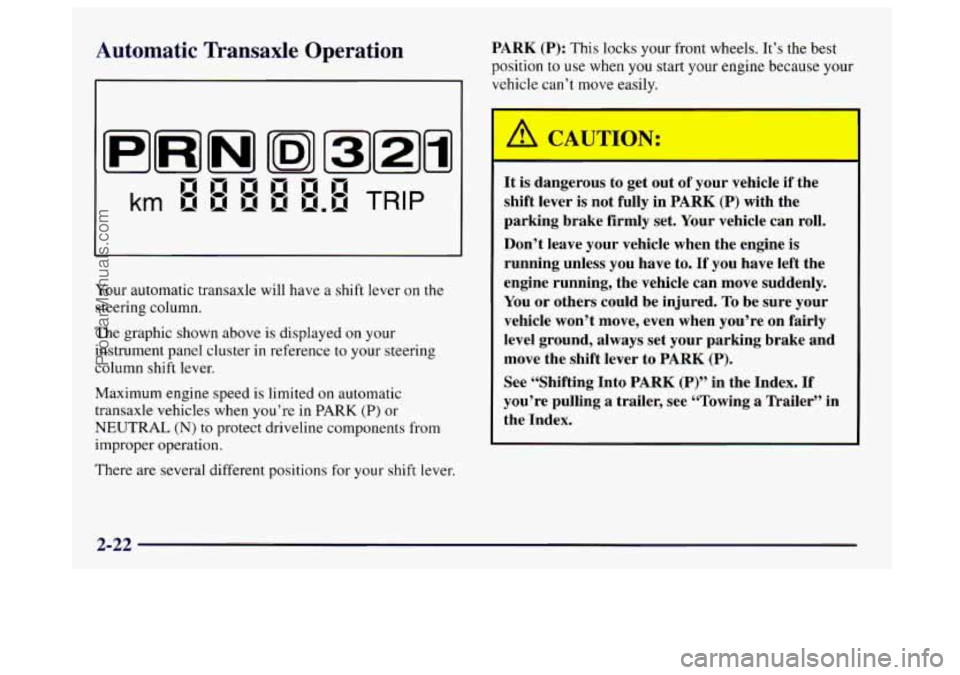
Automatic Transaxle Operation PARK (P): This locks your front wheels. It’s the best
position to use when you start your engine because your
vehicle can’t move easily.
Your automatic transaxle will have
a shift lever on the
steering column.
The graphic shown above is displayed on your
instrument panel cluster
in reference to your steering
column shift lever.
Maximum engine speed is limited on automatic
transaxle vehicles when you’re in
PARK (P) or
NEUTRAL (N) to protect driveline components from
improper operation.
There are several different positions for your shift lever.
L
CAUTIO,. :
It is dangerous to get out of your vehicle if the
shift lever is not fully in
PARK (P) with the
parking brake firmly set. Your vehicle can roll.
Don’t leave your vehicle when the engine is
running unless you have
to. If you have left the
engine running, the vehicle
can move suddenly.
You or others could be injured. To be sure your
vehicle won’t move, even when you’re on fairly
level ground, always set your parking brake and
move the shift lever to
PARK (P).
See “Shifting Into PARK (P)” in the Index. If
you’re pulling a trailer, see “Towing a Trailer” in
the Index.
2-22
ProCarManuals.com
Page 113 of 406
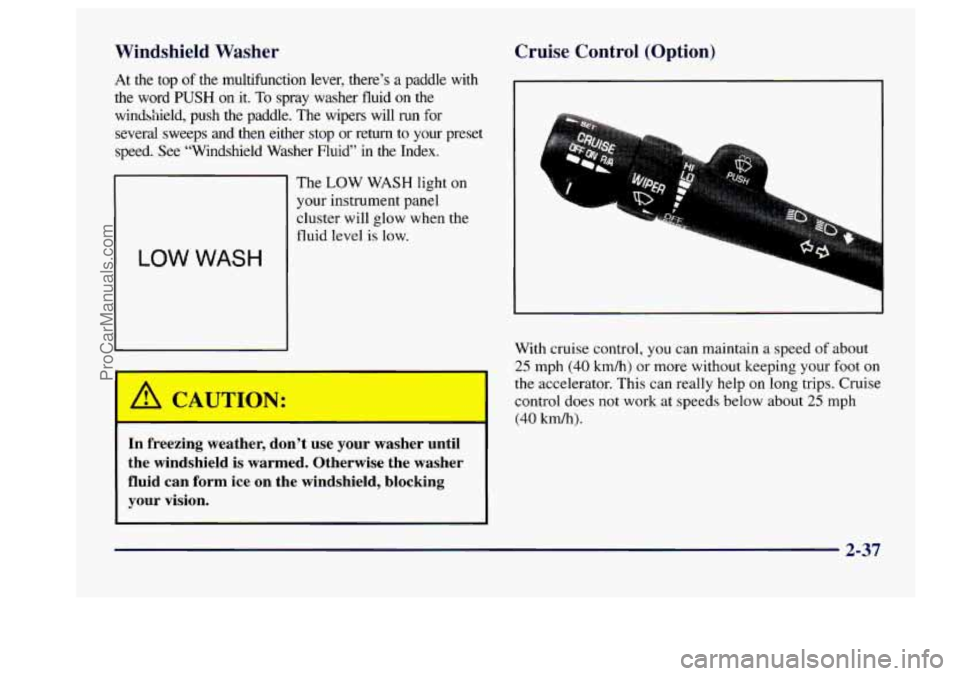
Windshield Washer
At the top of the multifunction lever, there’s a paddle with
the word
PUSH on it. To spray washer fluid on the
windshield, push the paddle. The wipers will run
for
several sweeps and then either stop or return to your preset
speed. See “Windshield Washer Fluid” in the Index.
LOW WASH
The LOW WASH light on
your instrument panel
cluster will glow when the
fluid level
is low.
I
In freezlng weather, don’t use your washer until
the windshield is warmed. Otherwise the washer
fluid can form ice
on the windshield, blocking
your vision.
Cruise Control (Option)
With cruise control, you can maintain a speed of about
25 mph (40 km/h) or more without keeping your foot on
the accelerator. This can really help
on long trips. Cruise
control does
not work at speeds below about 25 mph
(40 km/h).
2-37
ProCarManuals.com
Page 129 of 406

Instrument Panel -- Your Information System
A. Lamp Controls
B. Instrument Cluster
C. Vents
D. Glove Box
E. Audio System
E Climate Control
2-53
ProCarManuals.com
Page 130 of 406
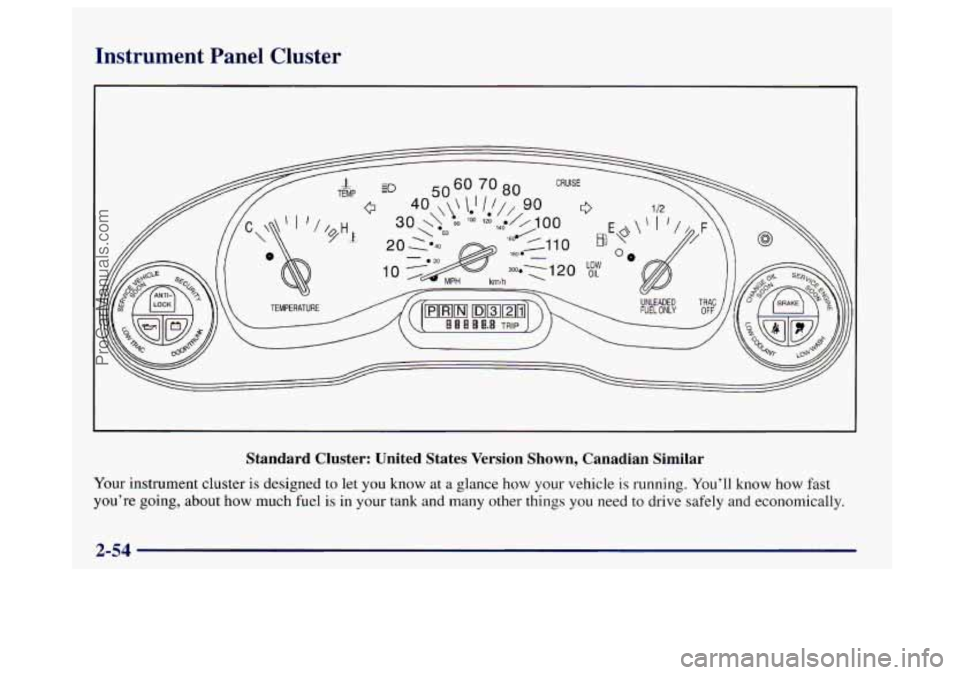
Instrument Panel Cluster
Standard Cluster: United States Version Shown, Canadian Similar
Your instrument cluster is designed to let you know at a glance how your vehicle is running. You’ll know how fast
you’re going, about
how much fuel is in your tank and many other things you need to drive safely and economically.
2-54
ProCarManuals.com
Page 131 of 406
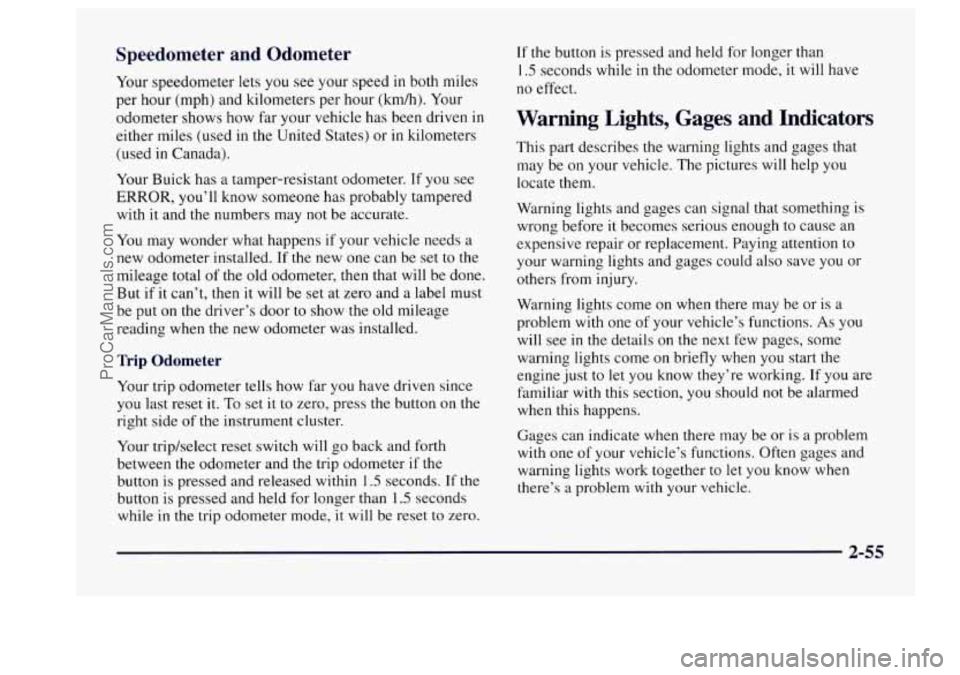
Speedometer and Odometer
Your speedometer lets you see your speed in both miles
per hour (mph) and kilometers per hour (kdh). Your
odometer shows how far your vehicle has been driven
in
either miles (used in the United States) or in kilometers
(used
in Canada).
Your Buick has a tamper-resistant odometer.
If you see
ERROR, you’ll know someone has probably tampered
with it and the numbers may not be accurate.
You may wonder what happens if your vehicle needs a
new odometer installed. If the new one can be set to the
mileage total of the old odometer, then that will be done.
But if it can’t, then
it will be set at zero and a label must
be put on the driver’s door
to show the old mileage
reading when the new odometer was installed.
Trip Odometer
Your trip odometer tells how far you have driven since
you last reset it. To set it to zero, press the button on the
right side of the instrument cluster.
Your triphelect reset switch will go back and forth
between the odometer and the trip odometer if the
button
is pressed and released within 1.5 seconds. If the
button is pressed and held for longer than
1.5 seconds
while in the trip odometer mode, it will be reset to zero.
If the button is pressed and held for longer than
I .5 seconds while in the odometer mode, it will have
no effect.
Warning Lights, Gages and Indicators
This part describes the warning lights and gages that
may be on your vehicle. The pictures will help you
locate them.
Warning lights and gages can signal that something is
wrong before it becomes serious enough to cause an
expensive repair or replacement. Paying attention to
your warning lights and gages could also save
you or
others from injury.
Warning lights come on when there may be or
is a
problem with one
of your vehicle’s functions. As you
will see in the details on the next few pages, some
warning lights come on briefly when
you start the
engine just to
let you know they’re working. If you are
familiar with this section, you should not be alarmed
when this happens.
Gages can indicate when there may be or is a problem
with one of your vehicle’s functions. Often gages and
warning lights work together to let you know when
there’s a problem with your vehicle.
2-55
ProCarManuals.com
Page 144 of 406
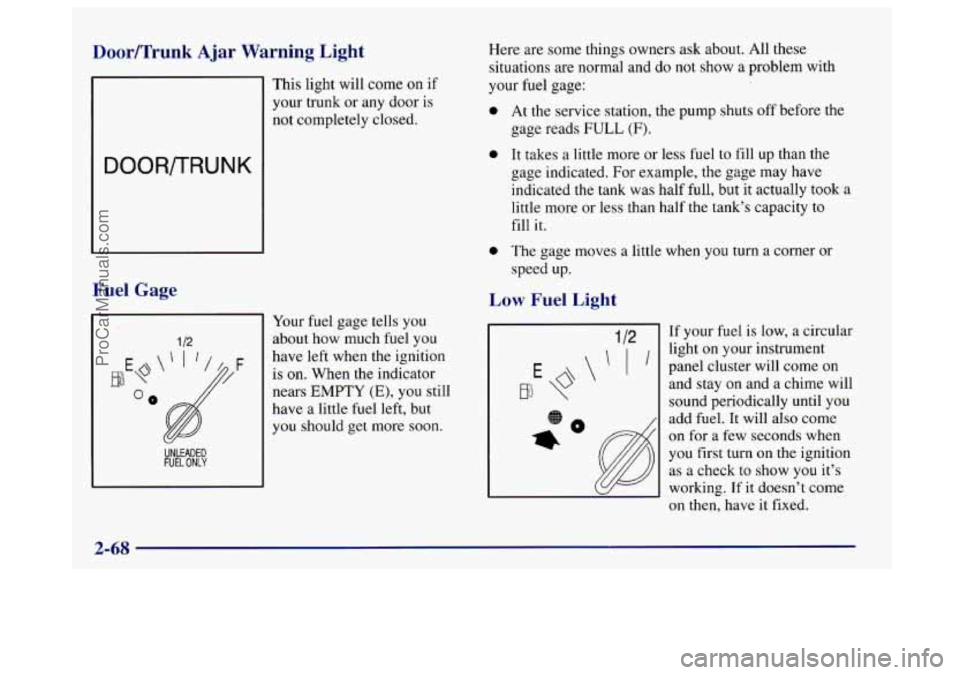
Door/Trunk Ajar Warning Light
DOORDRUNK
Fuel Gage
This light will come on if
your trunk
or any door is
not completely closed.
Your fuel gage tells you
about how much fuel you
have left when the ignition
is on. When the indicator
nears
EMPTY (E), you still
have a little fuel left, but
you should get more soon. Here
are some things owners
ask about. All these
situations are normal and
do not show a problem with
your
fuel gage:
0
0
0
At the service station, the pump shuts off before the
gage reads
FULL (F).
It takes a little more or less fuel to fill up than the
gage indicated. For example, the gage may have
indicated
the tank was half full, but it actually took a
little more or less than half the tank’s capacity to
fill it.
The gage moves
a little when you turn a corner or
speed
up.
Low Fuel Light
If your fuel is low, a circular
light on your instrument
panel cluster will come on
and stay on and a chime will
sound periodically until you
add fuel.
It will also come
on for a few seconds when
you first turn on the ignition
as a check to show you it’s
working.
If it doesn’t come
on then, have
it fixed.
2-68
ProCarManuals.com
Page 397 of 406
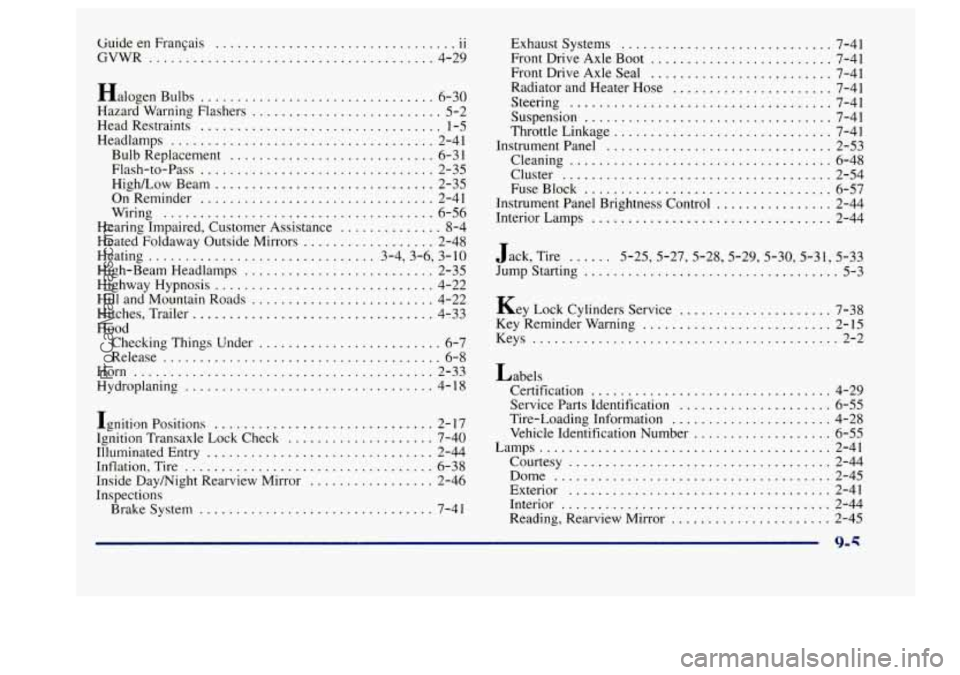
tiuide en Franpis 11
GVWR ....................................... 4-29
Halogen Bulbs
................................ 6-30
Hazard Warning Flashers
.......................... 5-2
Head Restraints
................................. 1-5
Headlamps .................................... 2-41
Bulb Replacement
............................ 6-3 1
Flash-to-Pass ................................ 2-35
High/LowBeam
.............................. 2-35
On Reminder
................................ 2-41
Wiring
..................................... 6-56
Hearing Impaired, Customer Assistance .............. 8-4
Heated Foldaway Outside Mirrors
.................. 2-48
Heating
............................... 3-4.3-6. 3- 10
High-Beam Headlamps
.......................... 2-35
Highway Hypnosis
.............................. 4-22
Hill and Mountain Roads
......................... 4-22
Hitches. Trailer
................................. 4-33
Hood Checking Things Under
......................... 6-7
Release
...................................... 6-8
Horn
......................................... 2-33
Hydroplaning
.................................. 4-18
Ignition Positions
.............................. 2- 17
Ignition Transaxle Lock Check
.................... 7-40
Illuminated Entry
............................... 2-44
Inflation. Tire
.................................. 6-38
Inside Day/Night Rearview Mirror
................. 2-46
Inspections Brakesystem
................................ 7-41
.. ................................. Exhaust Systems ............................. 7-41
Front Drive Axle Boot
......................... 7-41
Front Drive Axle Seal
......................... 7-41
Radiator and Heater Hose
...................... 7-41
Steering
.................................... 7-41
Suspension
.................................. 7-41
Throttle Linkage
.............................. 7-41
Instrument Panel
............................... 2-53
Cleaning
.................................... 6-48
Cluster
..................................... 2-54
FuseBlock
.................................. 6-57
Instrument Panel Brightness Control
................ 2-44
Interior Lamps
................................. 2-44
Jack. Tire
...... 5.25.5.27.5.28.5.29.5.30.5.31. 5.33
Jump Starting ................................... 5-3
Key Lock Cylinders Service
..................... 7-38
Key Reminder Warning
.......................... 2-15
Keys
.......................................... 2-2
Labels Certification
................................. 4-29
Service Parts Identification
..................... 6-55
Tire-Loading Information
...................... 4-28
Vehicle Identification Number
................... 6-55
Lamps
........................................ 2-41
Courtesy
.................................... 2-44
Dome
...................................... 2-45
Exterior
.................................... 2-41
Interior
..................................... 2-44
Reading. Rearview Mirror
...................... 2-45
ProCarManuals.com